| Author |
Message |
Nathan Robinson
myArmoury Admin


|
 Posted: Tue 21 Aug, 2007 8:06 pm Post subject: Seaxes found at the British Museum Posted: Tue 21 Aug, 2007 8:06 pm Post subject: Seaxes found at the British Museum |
 |
|
A couple years ago during my visit to The British Museum, I took photos of several pieces of arms and armour. Below are a few seaxes for you all to see.
Click photos to see larger versions!



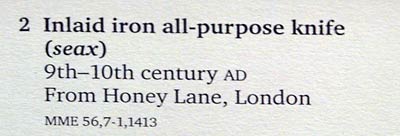
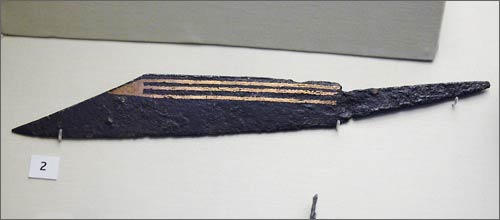
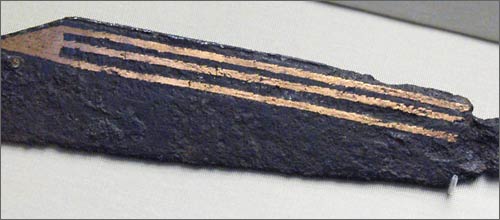

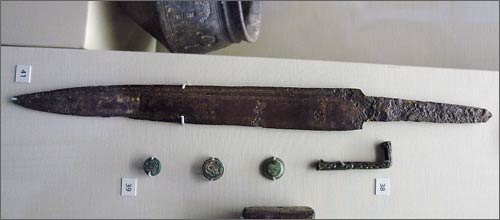
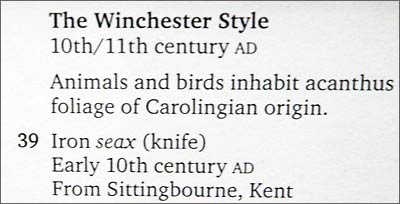
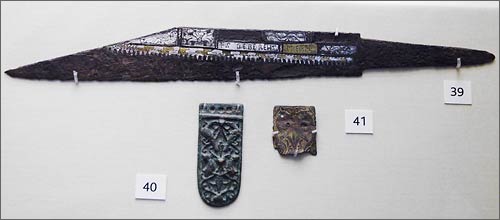
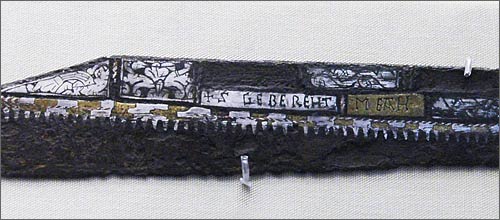


Note: #26 not photographed
Search words: British Museum, seax, photos, Battersea, Honey Lane, Sittingbourne, Winchester, Hampshire, Long Wittenham, Oxon, Beagnoth, Gebereht
.:. Visit my Collection Gallery :: View my Reading List :: View my Wish List :: See Pages I Like :: Find me on Facebook .:.
|
|
    |
 |
Nathan Robinson
myArmoury Admin


|
|
    |
 |
|
Tim Lison
|
 Posted: Sun 23 Mar, 2008 10:18 am Post subject: Posted: Sun 23 Mar, 2008 10:18 am Post subject: |
 |
|
Nathan-
Thanks for bumping this, I HAD missed it the first go around. Thanks for taking and posting these great pics. I've always loved the Beagnoth and Gebereht seaxes and it nice to get some really good photos of them.
|
|
  |
 |
G Ezell
Industry Professional

Location: North Alabama Joined: 22 Dec 2003
Posts: 235
|
 Posted: Tue 25 Mar, 2008 10:33 am Post subject: Posted: Tue 25 Mar, 2008 10:33 am Post subject: |
 |
|
|
Just out of curiosity, are there any other examples of saxes with an oddly angled tang like the Honey Lane, or is this the only one? (it is the only one I've seen) I cannot help but think that, sometime in it's life, it was bent to this angle by accident.
|
|
   |
 |
|
Ken Speed
|
 Posted: Tue 25 Mar, 2008 2:14 pm Post subject: Posted: Tue 25 Mar, 2008 2:14 pm Post subject: |
 |
|
"G wrote, "Just out of curiosity, are there any other examples of saxes with an oddly angled tang like the Honey Lane, or is this the only one? (it is the only one I've seen) I cannot help but think that, sometime in it's life, it was bent to this angle by accident."
Well, It doesn't seem to show any sign in the photograph of having been bent by accident to my admittedly untutored eye. I read your post and looked at the photo and I wonder if we are being misled by our own conventions. In the West typically, an edged weapon displayed in a horizontal position is displayed with the cutting edge down. Seaxes like the Honey Lane example, we are told, were carried horizontally in a sheathe with the edge up. My guess is that this is essentially a "quick draw" position and presents the blade in a way that makes an upward gutting stroke quick and easy. So, if you turned the Honey Lane seax over so that the blade faced up then the handle would angle down almost like a pistol grip and would make the "quick draw" gutting stroke all that much easier.Obviously long seaxes must have been worn in a manner similar to swords. I'm just guessing and have absolutely no proof that my explanation is correct.
Ken Speed
|
|
  |
 |
|
Ken Speed
|
 Posted: Tue 25 Mar, 2008 2:20 pm Post subject: Posted: Tue 25 Mar, 2008 2:20 pm Post subject: |
 |
|
Nathan,
Thanks for those pictures. The Honey Lane and Beagnoth seaxes are both incredible finds and in remarkable condition. Did you notice the seax that was in the opening photo of the thread about the Royal Ontario Museum? I sure wonder what that looked like before it accumulated a thousand years worth of corrosion. Even with the corrosion, you can still see what I think are the beautiful proportions of the blade.
Ken Speed
|
|
  |
 |
G Ezell
Industry Professional

Location: North Alabama Joined: 22 Dec 2003
Posts: 235
|
 Posted: Tue 25 Mar, 2008 5:36 pm Post subject: Posted: Tue 25 Mar, 2008 5:36 pm Post subject: |
 |
|
| Ken Speed wrote: | "G wrote, "Just out of curiosity, are there any other examples of saxes with an oddly angled tang like the Honey Lane, or is this the only one? (it is the only one I've seen) I cannot help but think that, sometime in it's life, it was bent to this angle by accident."
Well, It doesn't seem to show any sign in the photograph of having been bent by accident to my admittedly untutored eye. I read your post and looked at the photo and I wonder if we are being misled by our own conventions. In the West typically, an edged weapon displayed in a horizontal position is displayed with the cutting edge down. Seaxes like the Honey Lane example, we are told, were carried horizontally in a sheathe with the edge up. My guess is that this is essentially a "quick draw" position and presents the blade in a way that makes an upward gutting stroke quick and easy. So, if you turned the Honey Lane seax over so that the blade faced up then the handle would angle down almost like a pistol grip and would make the "quick draw" gutting stroke all that much easier.Obviously long seaxes must have been worn in a manner similar to swords. I'm just guessing and have absolutely no proof that my explanation is correct.
Ken Speed |
I've seen a few old bowies with a similar angled grip, I can only agree that some throughout history like them this way. I can't tell from photos if it was forged that way or bent later. I once used a kukri (a rather poorly made one) for some heavy chopping, and the tang bent in a very similar manner. A mild steel or wrought iron tang can bend pretty easily. It is just that I have seen no other seax built like it, so I have to wonder.
|
|
   |
 |
|
Ken Speed
|
 Posted: Tue 25 Mar, 2008 7:48 pm Post subject: Posted: Tue 25 Mar, 2008 7:48 pm Post subject: |
 |
|
Hi G,
Yeah, I'm guessing for all intents and purposes. I've never seen it in person, just photos. I'm sure lots of people here other than Nathan have seen it in the flesh maybe someone can tell us what it looked like to them. All I can say is that it seems to me that if the tang were that grossly damaged it would probably be noted in the photos or by the museum.
OK, another theory! Hey, they're cheap, you can have all you want. The Museum describes it as an, "all purpose knife".
Maybe that is exactly what it is, a knife, and the tang has that tilt just to get fingers out of the way when slicing.
If my first guess is right I think it sure would have been a wicked weapon when things got up close and personal!
Ken Speed
|
|
  |
 |
|
Jeremy V. Krause
|
 Posted: Wed 26 Mar, 2008 1:23 pm Post subject: Posted: Wed 26 Mar, 2008 1:23 pm Post subject: |
 |
|
For those who may be interested,
Here is my seax inspired by the honey lane example. I t is my hope that this type of knife would be contemporary to this example. Perhaps it gives a notion as to how some of these beautiful specimen would have looked when new.
Seeing these again gets my wheels turning as to another commission!
Jeremy
I MUST find out what is on the other side of these pieces!!
 Attachment: 148.79 KB Attachment: 148.79 KB
[ Download ]
|
|
  |
 |
|
Ken Speed
|
 Posted: Wed 26 Mar, 2008 3:42 pm Post subject: Posted: Wed 26 Mar, 2008 3:42 pm Post subject: |
 |
|
Jeremy,
Thank you for the picture. I think I remember the pictures when you first got this seax, didn't Tod of Tod's Stuff make this for you?
What type of wood is the handle made from and are those pins decorating the butt of the handle?
It is a beautiful piece.
Thanks
Ken Speed
|
|
  |
 |
|
Jeremy V. Krause
|
 Posted: Wed 26 Mar, 2008 4:36 pm Post subject: Posted: Wed 26 Mar, 2008 4:36 pm Post subject: |
 |
|
Hi Ken,
Yes, Tod made this for me- along with Owen Bush who made the blade- and I can't reccommend him enough. It was ordered through Tod- who handled everything. The grip is spalted box wood and is especially striking- and those are copper pins in the end.
Comparing mine and the Honey Lane example you can see significant difference in the blade shapes- so "inspiration" is really the operative work here. But man- now that I have one I realize how neat these things are. My original premise with going for a seax was my desire to have a combat knife that could have possibly been seen in the early middle ages (1000-1100). Many of us are aware of the "hole" in archeological finds relative to knives pre 14th C. and I wanted something that might fit my desire. . .
But now that I have my seax I see the beauty in these specimens- and am not as bothered by what I feel is the inability to have a truly authentic combat knife of the early medieval period. Sometimes we don't know what we are looking for it seems.
Jeremy
|
|
  |
 |
|
Ken Speed
|
 Posted: Wed 26 Mar, 2008 5:31 pm Post subject: Posted: Wed 26 Mar, 2008 5:31 pm Post subject: |
 |
|
Hi Jeremy,
I neglected to mention that I'm really impressed with the sheathe too. It has more than a touch of barbarism in it and yet it looks (and I'm sure it is) well crafted.
OK, How does it handle? Does handling your seax give you any insight into the question about the off line haft on the Honey Lane seax?
Ken Speed
|
|
  |
 |
|
Jeremy V. Krause
|
 Posted: Wed 26 Mar, 2008 6:27 pm Post subject: Posted: Wed 26 Mar, 2008 6:27 pm Post subject: |
 |
|
An interesting question Ken,
First of all- it handles fabulously- and like nothing else I can think of. The expanding blade adds a bit of weight to the cutting (chopping) movement. This thing feels scary when brought up to speed. Saying that it in no way has a "bland" feeling of a simple chopping implement and this must be due to the long broken back section and needle like point which add a dynamic feel.
As a absolute seax newbie it is hard for me to speak more abut the specifics but frankly, I can't see the benefit of the off-center tang if it was done on purpose. If it were bent the other way I might be able to- as it would add to the forward inertia. I really don't know the specifics of how a seax like this would be used. I do know that it would be used for chopping motions because that screams out at you when you wield it. Others more familiar with how seaxes were employed would have to educate me. For instance- I do not know if an individual would have employed a dagger like reverse grip at times.
Thinking about the possibly accidently bent or on-purpose- off center tang- due to my ignorance I cannot give a strong opinion. But, frankly I can't see the benefit of this design
But guys I am not an Anglo-saxon warrior- I am an American Social Worker. Many features of historical weapons have designs that seems counter-intuitive to me- and this may be an example of that.
I am not one for theorizing about weapon usage. I like to rest on the research and passion that those with more time than I put into the subject. I like owning and wielding these things. I am not a martial artist or versed in combat of any kind so my opinions would be worth a grain of salt!!
Do others think that a seax like this would have been reversed in the hand? I do feel comfortable stating that the handshake grip seems much more likely than the hammer grip.
Jeremy
|
|
  |
 |
|
Korey J. Lavoie
Location: New Hampshire, USA Joined: 06 Apr 2006
Posts: 63
|
 Posted: Thu 27 Mar, 2008 2:45 am Post subject: Posted: Thu 27 Mar, 2008 2:45 am Post subject: |
 |
|
I know of certain examples of axes fitted with handles that curve backward in a manner that might be comparable to the Honey Well seax: One of Granfors Bruks' axes shows this in a more minor form. On an ax, this increases ergonomics as well as the amount of force generated, the backward curve brings the bit of the ax into better alignment with the common hand-position used for swinging an ax. This causes the bit to strike square on.
That being stated, I strongly suspect that the Honey Well seax was bent by accident: Simply having the handle bent straight would be very awkward to grip. If the handle curved in an arc, I might consider it but otherwise, I can't see it working.
I also Love seeing these old styles and their clear similarity to English Style Bowie knives. I'd like to know exactly who started making Bowie knives for export to the American Frontier and using the Seax as a blatant inspiration.
From the hundred year war
To the Crimea
With a Lance and a Musket and a Roman Spear
To all of the Men who have stood with no fear
In the Service of the King
-The Clash: The Card Cheat
|
|
  |
 |
G Ezell
Industry Professional

Location: North Alabama Joined: 22 Dec 2003
Posts: 235
|
 Posted: Fri 28 Mar, 2008 8:41 am Post subject: Posted: Fri 28 Mar, 2008 8:41 am Post subject: |
 |
|
| Korey J. Lavoie wrote: |
I also Love seeing these old styles and their clear similarity to English Style Bowie knives. I'd like to know exactly who started making Bowie knives for export to the American Frontier and using the Seax as a blatant inspiration. |
The majority of Bowies shipped to the new world back in the day came from England, Sheffield in particular. Everyone wanted a knife like Jim Bowie's, but virtually no one knew what his knife looked like, other than that it was big and single-edged. I cannot help but think that, the Sheffield cutler, who was asked to make a big fearsome knife, would choose the seax as the model for this big fearsome knife. Be it racial memory of maurading Saxons, or actually having seen the artifacts occasionally pulled from rivers, I do not know, but the inspiration is obvious. They simply made a few changes based on the style of the day, adding the riccasso, hilt/guard, and false edge, all of which were found on 18th century swords but not original seaxes. We Americans fell in love with the style, even though in reality the original knife that Mr. Bowie carried was likely just a simple stout butcher's knife with a straight back...
I have wondered about the way the seax was carried and sheathed, and how it was drawn and put into use. I do find it plausible that the blade was used with the edge facing up, at least in combat, although the forward balance would favor the type of chopping cuts that Mr. Krause speaks of, which would favor the standard edge down grip. Were they held like a dagger in an icepick grip? I'm sure it happened on occasion, but I do not think it was the norm. Although almost all seax had very serviceable points, the lack of a guard makes one wonder how often they were used for stabbing, as opposed to delivering horrendous cuts. However, in the two parts where seaxes are mentioned in 'Beowulf', they appear to be used as stabbing weapons primarily. The shape of the handles on the few surviving seaxes that have them make it difficult to reach any conclusion. Some were defiantly not set up for it (the seax of Charlemagne comes to mind), while others handles widened towards the blade or were highly textured/carved making it more likely they could be used for thrusts safely.
We will likely never know, the world has moved on.
|
|
   |
 |
|
Jeremy V. Krause
|
 Posted: Sun 30 Mar, 2008 8:58 am Post subject: Posted: Sun 30 Mar, 2008 8:58 am Post subject: |
 |
|
Hello Guys,
I am in Osaka now and so I am a bit effected by jet lag but I have a funny/stupid story involving myself and my beautiful seax. The day before I flew out I was thinking of this issue of the drawing and "gutting" idea of the quick draw of this type of seax. I was holding the seax in front of me (where it would be if it was properly suspended in it's sheath- and quickly moving it forward and up AND- SKQUICK!!-- I stuck myself in my thigh. This was a very clean- but deep (2-3 inches) puncture wound which required only 3 external stitches. And so now I am in Japan with a stitched up wound- thus far not infected- and I hope and believe it will not be infected. It hurts only very little and I walk with only a slight limp which is gettig better as time goes on. . . Especially with all the excellent sushi (and sake).
My accident did show me that especially when moving at full speed- one must be SO CAREFUL when handling these things.
This simple wound of mine may have been catastrophic to someone before the time of sterility and sound medical practice.
In any case- I guess that my seax had to taste blood- even through the incompetence of it's owner. I just wanted to share.
Jeremy
|
|
  |
 |
|
B. Fulton
|
 Posted: Sun 30 Mar, 2008 2:55 pm Post subject: Posted: Sun 30 Mar, 2008 2:55 pm Post subject: |
 |
|
|
Per the massive museum picture request thread in the offtopic forum, I was in the Brit Museum a couple days ago. I hadn't planned on going (scheduling conflict) but time was there, so we did a 90-minute Viking loot and pillage of the place and shot everything we could find and had both camera memory and time for. Two of the saxes shown I have pics of, including some decent closeups I believe, i'll try and post them in the next couple days, but I just arrived in Ireland and will be traveling quite a bit before heading to France, so.... might have to wait till I'm home. The BM is in the middle of a big reshuffling, so a lot of the stuff I wanted to see was not available.
|
|
  |
 |
|
Ken Speed
|
 Posted: Sun 30 Mar, 2008 4:00 pm Post subject: Posted: Sun 30 Mar, 2008 4:00 pm Post subject: |
 |
|
Jeremy wrote, "... The day before I flew out I was thinking of this issue of the drawing and "gutting" idea of the quick draw of this type of seax. I was holding the seax in front of me (where it would be if it was properly suspended in it's sheath- and quickly moving it forward and up AND- SKQUICK!!-- I stuck myself in my thigh. "
Wow, Jeremy, I feel responsible for your injury inasmuch as I was the one who told you about the carrying position of the seax. I'm glad you're OK. Why don't you tell your Japanese hosts its a war wound? Seriously, I'm glad you weren't injured more severely. Be more careful!!
Ken Speed
|
|
  |
 |
Jean Thibodeau

|
 Posted: Sun 30 Mar, 2008 9:27 pm Post subject: Posted: Sun 30 Mar, 2008 9:27 pm Post subject: |
 |
|
| Jeremy V. Krause wrote: | Hello Guys,
I am in Osaka now and so I am a bit effected by jet lag but I have a funny/stupid story involving myself and my beautiful seax. The day before I flew out I was thinking of this issue of the drawing and "gutting" idea of the quick draw of this type of seax. I was holding the seax in front of me (where it would be if it was properly suspended in it's sheath- and quickly moving it forward and up AND- SKQUICK!!-- I stuck myself in my thigh. This was a very clean- but deep (2-3 inches) puncture wound which required only 3 external stitches. And so now I am in Japan with a stitched up wound- thus far not infected- and I hope and believe it will not be infected. It hurts only very little and I walk with only a slight limp which is gettig better as time goes on. . . Especially with all the excellent sushi (and sake).
My accident did show me that especially when moving at full speed- one must be SO CAREFUL when handling these things.
This simple wound of mine may have been catastrophic to someone before the time of sterility and sound medical practice.
In any case- I guess that my seax had to taste blood- even through the incompetence of it's owner. I just wanted to share.
Jeremy |
Glad you didn't do yourself worse damage like cutting some tendons, a vein or artery.
I would guess that it was a question of " point control " in that your point drifted back when out of the sheath instead of strait out !? Maybe a general tendency to pull a blade back to get more power out of a strike ? ( Cocking the wrist ??? )
Also, point control in the sense that one should always be aware of were it's pointing as well as were the edge is next to.
Probably a good idea to try these things out progressing from dead slow to quarter speed, half speed and finally full speed when the motion and control is acquired.
Anyway, it might be " educational " for us and you to know how you did this to yourself ? Use something harmless like a wooden ruler and repeated the motion and see exactly what you are doing as opposed to what you thought you were doing.
You can easily give up your freedom. You have to fight hard to get it back!
|
|
  |
 |
Leo Todeschini
Industry Professional

|
 Posted: Mon 31 Mar, 2008 1:45 am Post subject: Posted: Mon 31 Mar, 2008 1:45 am Post subject: |
 |
|
Hi Guys,
The tang on the Honey lane blade is an interesting one. I am away from my books at the moment so have to rely on memory, but I seem to remember that shorter seaxs often have a slight bend in the tang like this even though this is very pronounced.
It could be a bend as the metal is quite thin here compared to the blade and would only be wrought, no steel at this point, so easy enough to bend if that is what was wanted or by accident. However if I remeber right this is a small blade of 4" or so and so I doubt it was a weapon so that leaves it as a general knife for general duties and this would cover eating/food preperation. Anyone who has cooked can tell you a small knife with a blade edge in line with the handle would be horrible to use. From my perspective, I would think that the tang bend will improve its usability as a general knife and so I would think it was deliberate, though as I said above it could have certainly happened by accident, though if it had it could have been bent back with no damage done and so I would have expected this.
I conclusion I think the tang bend is deliberate and to make the knife easier to use.
Jeremy what can I say. I assume that your wound falls into a category that I have certainly fitted into many times and that is 'Why did I just do that?' All I can say is that you learn from it and then generally find some other creative way to injure yourself. I once slit my wrist sharpening a Seax (different one - this isn't cursed!) and that takes some explaining down at the ER. Good luck with it and it will at least give you a good dinner party story.
Regards
Tod
www.todsworkshop.com
www.todcutler.com
www.instagram.com/todsworkshop
https://www.facebook.com/TodsWorkshop
www.youtube.com/user/todsstuff1
|
|
   |
 |
|
|
You cannot post new topics in this forum
You cannot reply to topics in this forum
You cannot edit your posts in this forum
You cannot delete your posts in this forum
You cannot vote in polls in this forum
You cannot attach files in this forum
You can download files in this forum
|
All contents © Copyright 2003-2025 myArmoury.com — All rights reserved
Discussion forums powered by phpBB © The phpBB Group
Switch to the Basic Low-bandwidth Version of the forum
|

